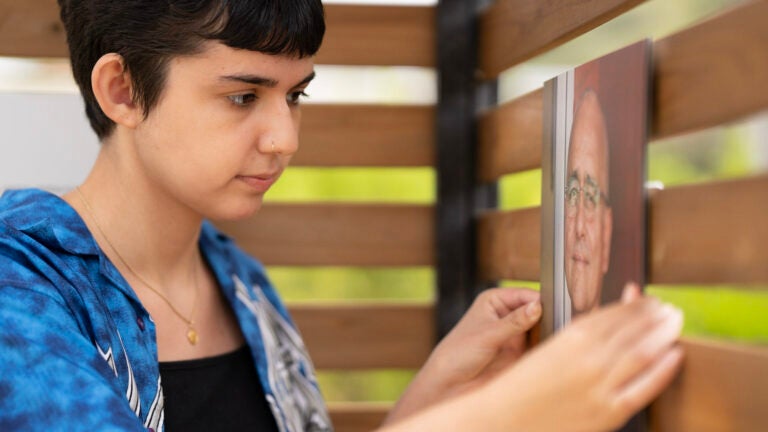
USC Annenberg graduate Maria Eberhart ‘23 hangs a portrait of Carlos Cortez, a Boyle Heights restaurant owner and longtime Los Angeles resident, at the Wrigley Marine Science Center’s outdoor Art Park as part of “My Story is a Climate Story.” (Nick Neumann/WIES)
“My Story is a Climate Story” on display at the Wrigley Marine Science Center
What or who gets to be the face of climate change? For years, imagery of polar bears on melting sea ice have been used to convey the pressing reality of the environmental crisis. While the effects of climate change are undoubtedly pronounced in the Arctic, its impacts in our local communities are often overlooked.
“My Story is a Climate Story” reshapes the narrative of climate change from one of a distant and abstract danger into one of a threat that is increasingly impacting how our neighbors work and live today. The exhibit is currently on display at the Wrigley Marine Science Center (WMSC) on Catalina Island.
Commissioned by Allison Agsten, the inaugural director of USC Annenberg’s new Center for Climate Journalism and Communication (CCJC) and the Wrigley Institute for Environment and Sustainability’s first curator, the project reflects CCJC’s mission of telling people-first stories that humanize the impacts and science behind climate change.
“My Story is a Climate Story” consists of portraits of South and East Los Angeles residents taken by Maria Eberhart (B.A., Journalism ‘23), with accompanying text by Shreya Agrawal (B.S., Geological Sciences, B.A., English; and M.A., Journalism ‘23) detailing the residents’ experiences in September 2022’s historic heatwave. During the heatwave, which covered Los Angeles in a “heat dome” over ten days, temperatures reached all-time record highs.
Initially, Eberhart sought to identify portrait subjects through Los Angeles-based social justice organizations. When Star Montana (M.F.A. ‘19) – who served as the visual advisor for the project and whose own art centers the stories of her Boyle Heights community – suggested that impromptu in-person interactions might elicit the most compelling photographs, Eberhart shifted course.
“I started walking around different neighborhoods in Los Angeles that faced the highest risk of climate impact,” Eberhart said at USC’s 2023 Climate Forward Conference, where the project was first displayed in early April. “These communities lack the cooling infrastructure that wealthier neighborhoods take for granted, resources like trees and parks that can absorb heat.”
“I spoke to people outside cooling centers in South L.A., walking to class at L.A. City College, selling t-shirts near Exposition Park, and working at a restaurant in Boyle Heights. Most of them were born and raised in Los Angeles and noticed the unusually severe heat affecting the city.”
Carlos Cortez, a longtime L.A resident and Boyle Height restaurant owner, shared in his interview with Eberhart that he normally experiences a drop in sales in the summertime as customers avoid venturing out due to the heat. In September’s extreme weather, however, he had to completely close his restaurant for a week-and-a-half.
In capturing the portraits and listening to each resident’s story, Eberhart realized that not only is climate change happening now in her own city, but also that its most adverse impacts are felt by low-income communities and communities of color. Her hope for “My Story is a Climate Story” is to convey both messages and to spark a sense of urgency to bring forth meaningful change.
Given the project’s alignment with the Wrigley Institute’s mission to inspire actionable and equitable solutions for environmental challenges, it was only fitting to bring the art installation to the Wrigley Marine Science Center’s outdoor Art Park.

Installed in the middle of the WMSC campus, the exhibit will be on display during the research center’s busiest time of the year. From May to early August, WMSC will welcome a wide range of visitors: undergraduate students in the Wrigley Institute’s Maymester Program, divers-in-training from the Scientific Diving Discovery Program, faculty and graduate students conducting field research on the island, and more.
“As a physical space, the Art Park shares little in common with stark, temperature-controlled museums. I am curious to see what our visitor experience will be like this summer, when people encounter work about heat while [experiencing] the heat themselves,” Allison Agsten says.
As Agsten continues her role as Wrigley Institute curator, she plans to develop more site-specific projects that are responsive to people and their environments.
“I also think it would be great to create more opportunities for artists and scientists to intersect, on Catalina, at USC’s main campus, and beyond,” she says.